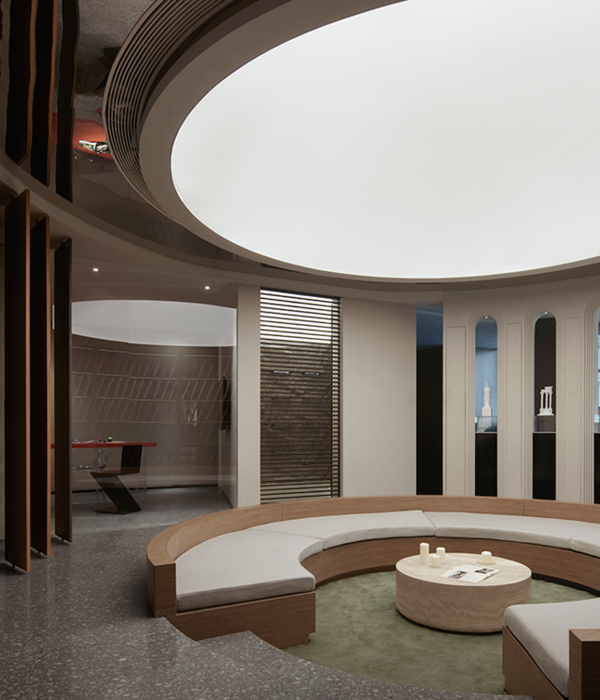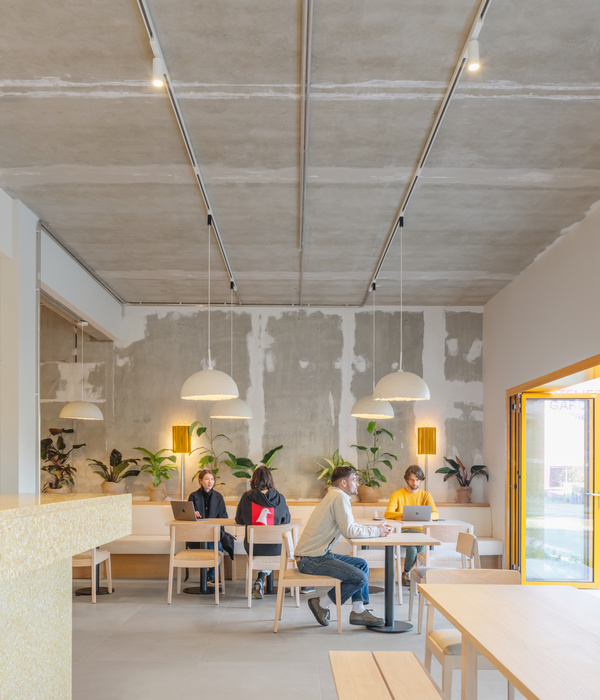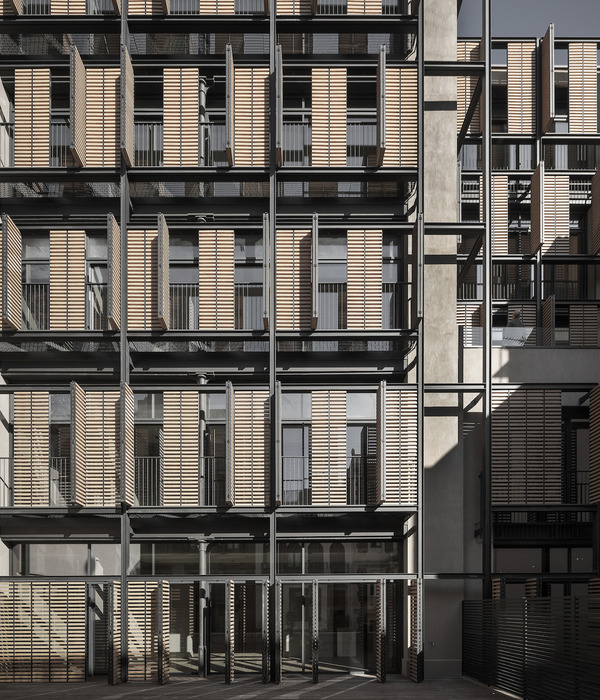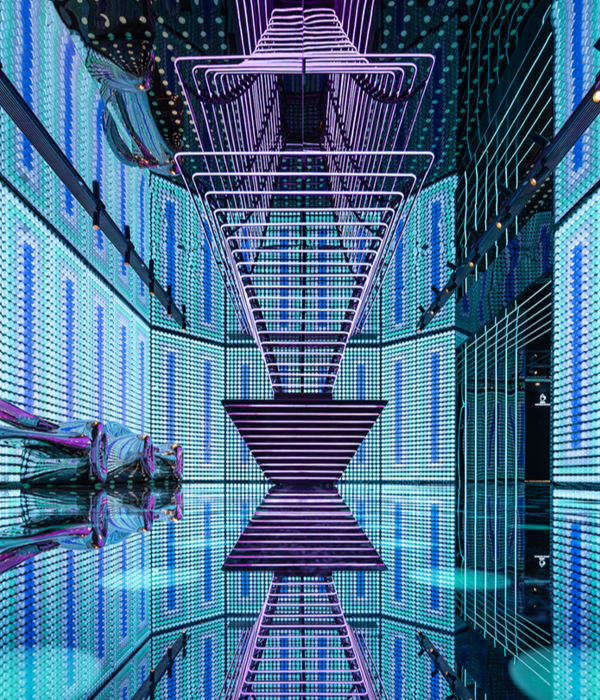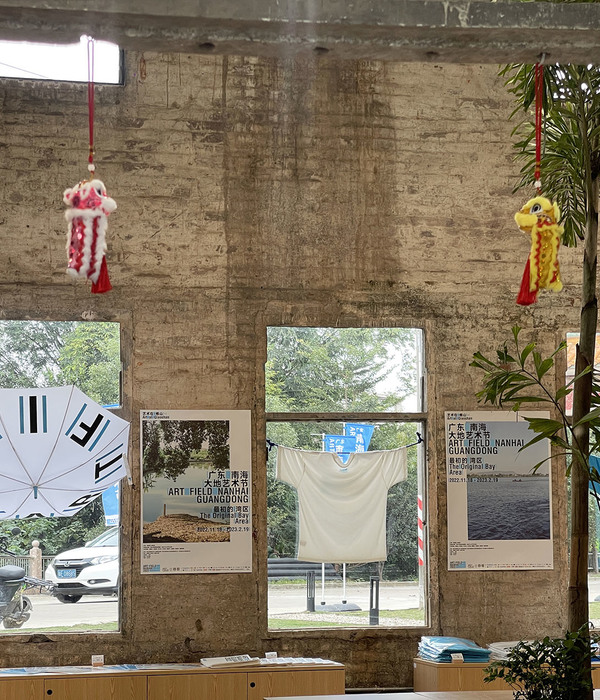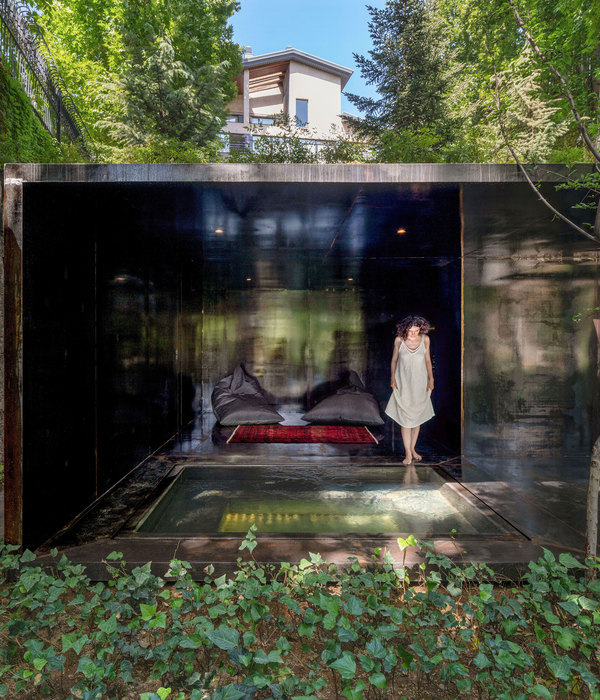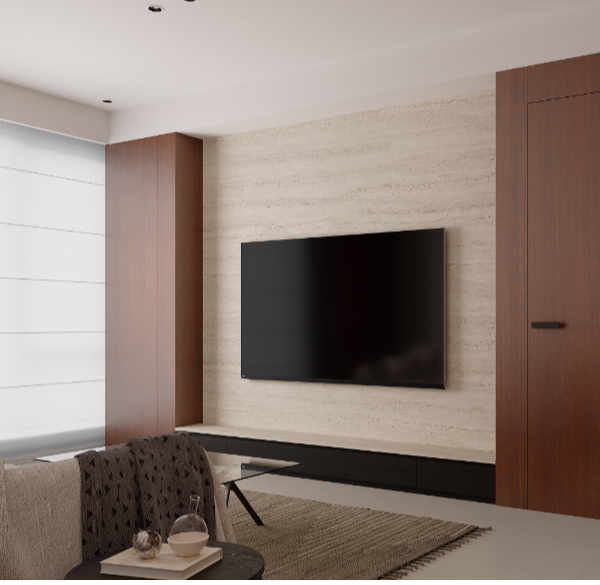该项目赢得马德里政府发起的公共竞赛,将西贝莱斯邮政大楼改造成新的公共空间。大楼建于二十世纪初,由Antonio Palacios和Joaquín Otamendi设计,曾经作为邮局使用,如今用作文化中心。设计团队对其内部空间进行了一系列改造。
Colgando del Centro is the result of a public competition called by Madrid City Council (Madrid Destino) in order to adapt the existing Operations Court of Cibeles Palace as a new public space for the city of Madrid. Therefore, the project consists of a number of interventions inside the old Telecommunications Palace, built at the beginning of the 20th century as the Post Office by Antonio Palacios and Joaquín Otamendi. Today it serves as the home of CentroCentro cultural space.
▼项目概览,overview © Montse Zamorano
大楼的历史背景要求改造不破坏原有结构并且可以恢复原状。项目主要由可移动结构组成,必要时可隐藏主要元素和家具,只对原有中庭进行轻微改造。通过新的区域规划加强了接待、信息和参与功能,明确了中庭的内部空间组织。并置入新的家具和吊灯、增强空间的多功能性、促进信息交流,从而完成改造。
The historical context of the project conditioned the nature of the intervention, turning the proposal into a reversible intervention, without affecting any original structural element. In addition, it is mainly a mobile construction, so it would be possible to hide its main elements and furniture when necessary, thus creating a slight modification on the current morphology of the Operations Courtyard.The goal of the project was to intensify the reception, information and participation functions through a new zoning strategy that clarifies the interior organization of the Courtyard. In order to implement this design strategy, we included new furniture pieces and hanging structures that illuminate, multiply the versatility of the space and facilitate the exchange of information.
▼入口关闭与开放,entrance closing and opening © Héctor Fernández Elorza
入口:由于建筑本身及其立面的纪念性,该项目不仅作为通向文化中心的大门,也是马德里的门户象征。因此设计团队设计了新的入口,不仅解决了之前大门缺乏气候舒适性的问题,还在不大幅改动原有建筑外观的情况下,创造了门厅空间。新入口由三个不锈钢主体和玻璃内门组成,使文化中心与城市之间产生视觉联系。中间体块内设置旋转门,两侧为紧急出口。
Access: Due to the monumental nature of the building and its facade, the project was understood as a gateway, not only to CentroCentro, but to the city of Madrid. Therefore, we proposed a new entrance gateway that allows solving the serious problem of loss of climatic comfort that the previous system produced in the building. Additionally, it frees up the entrance hall to the building without losing or substantially modifying the exterior view of the Palace.The new access consists of three stainless steel bodies and interior glass doors that allow the visual and transparent connection between the Center and the city. The central body allows entry through a revolving door and the sides work as emergency exits.
▼入口立面,entrance facade © Montse Zamorano
▼大门,gateway © Montse Zamorano
▼细部,details © Montse Zamorano
问讯处:新问讯处位于文化中心的中央,正对入口。圆形的问询台为文化中心和马德里的游客提供了咨询点。从室内和室外观看,悬挂在空中的吊灯是空间的焦点。
Information desk: The new information point is located right in the center of the cultural center and opposite the new access. This circular information desk works as an information point for tourists both for CentroCentro and the city Madrid. Its hanging lighting structure serves as a claim both from the inside and the outside of the building.
▼新问讯处位于文化中心的中央,正对入口,new information point is located right in the center of the cultural center and opposite the new access © Montse Zamorano
▼圆形的问询台,circular information desk © Montse Zamorano
▼俯瞰问讯处,悬挂吊灯是空间的焦点 © Montse Zamorano overlooking the information desk,hanging lighting is the focus of space
▼细部,details © Montse Zamorano
中央大厅:中央大厅由三部分组成,其巨大的规模为该项目带来了无限的可能性。中厅的帷幕与照明系统是该项目的主要特征之一,它们悬挂在原有的钢结构上,围合出可以自由布局的内部空间。这里可以举办各种活动,包括从市政会议、儿童工作坊到研讨会或不同组织的聚会等大型活动。
Central nave: The Operations Courtyard space is divides into three naves. Its monumental scale creates an infinite number of possibilities in terms of its program. One of the main features of the projects is the system of curtains and lighting that we proposed for this nave. They work as a hanging structure suspended form the original steel structure of the building. This system allows to configure new domestic spaces within its central nave. The new structure could host events ranging from a townhall meeting, a workshop for children, to a larger venue like a conference or institutional gatherings.
▼中央大厅,central nave © Montse Zamorano
▼可移动的帷幕,movable curtain © Montse Zamorano
▼灵活多变的内部空间,flexible interior space © Montse Zamorano
休息区和工作区:中庭周围是小尺度的回廊空间,它们由原邮局的柜台围合而成。该项目将这些柜台变成储藏新家具的空间。
Resting and working areas: The three naves are surrounded by smaller-scale ambulatory spaces. This perimeter limits with a line of historical counters that were originally used as the Post Office desks. The project turns these counters into the storage space for the new furniture pieces.
▼工作区,working areas © Montse Zamorano
商店:设计团队更换了商店的位置,依据其他部分的设计原则重新设计了内部家具,结合了固定柜台以及可以分散在整个空间的可移动家具。Gloria Fuertes房间:为公众创造的新空间,支持文化中心的活动。标识:设计团队按照项目的主要思路,在原有钢结构上悬挂新的标识,提供资讯。
Shop: We have relocated the store space and redesigned its furniture following the same principles as in the rest of the project. It combines both fixed counters and mobile furniture pieces, which can be distributed throughout the Operations Court.Gloria Fuertes Room: A new space for the public that supports the activities of CentroCentro.Signage: Following the main idea of the project, we designed new elements of signage and information of the building through hanging structures from the steel structure of the existing building.
▼可移动的家具,movable furniture © Montse Zamorano
该项目在尊重历史建筑的基础上进行了一系列改造,赋予原有建筑的尺度、颜色、材质和灯光新的价值,带来了新的变化和吸引人的活动,使文化中心成为马德里的代表地点。
In conclusion, the project aims to be a respectful intervention inside the historical Telecommunications Palace through a series of actions that give value to the scale, color, materials and light of the existing building. Colgando del Centro aims to provide the building with a new changing and attractive program of activities, turning this Center into a reference point for the city of Madrid.
▼俯视图,top view © Héctor Fernández Elorza
▼总平,site plan © Héctor Fernández Elorza
▼平面图,plan © Héctor Fernández Elorza
▼剖面图,section © Héctor Fernández Elorza
Architects: Héctor Fernández Elorza Collaborators: Violeta Ordoñez Manjón (Architect), Javier Estebala Alández (Architect), Mireia Carrasco Ferri (Architect), Guillermo Pozo Arribas (Architect), Ismael López Portilla (Architect), Javier Moraleda Perulero (Architect), María Risueño Domínguez (Architect), Ignacio Delgado Conde (Technical architect) Site: Palacio de Cibeles. Plaza de Cibeles, 1 28014. Madrid. Competition: 2016 Project: 2018 Start of construction: January 2019 End of construction: November 2019 Client: Madrid Destino Intervention surface: 2200 m² Budget: 715.000 euros Picture credits: Montse Zamorano
{{item.text_origin}}

